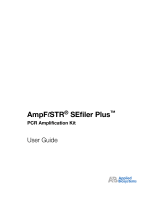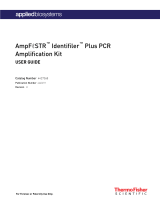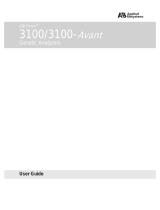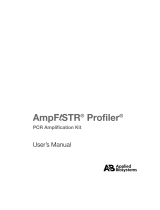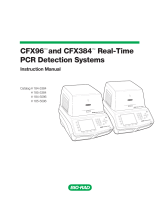Page is loading ...

AmpFlSTR® Sinofiler™
PCR Amplification Kit
User Guide


AmpFlSTR® Sinofiler™
PCR Amplification Kit
User Guide

© Copyright 2012 Life Technologies Corporation. All rights reserved.
Information in this document is subject to change without notice. Applied Biosystems assumes no responsibility for any errors that
may appear in this document.
APPLIED BIOSYSTEMS DISCLAIMS ALL WARRANTIES WITH RESPECT TO THIS DOCUMENT, EXPRESSED OR
IMPLIED, INCLUDING BUT NOT LIMITED TO THOSE OF MERCHANTABILITY OR FITNESS FOR A PARTICULAR
PURPOSE. IN NO EVENT SHALL APPLIED BIOSYSTEMS BE LIABLE, WHETHER IN CONTRACT, TORT, WARRANTY,
OR UNDER ANY STATUTE OR ON ANY OTHER BASIS FOR SPECIAL, INCIDENTAL, INDIRECT, PUNITIVE,
MULTIPLE OR CONSEQUENTIAL DAMAGES IN CONNECTION WITH OR ARISING FROM THIS DOCUMENT,
INCLUDING BUT NOT LIMITED TO THE USE THEREOF.
Applied Biosystems, AB (Design), ABI PRISM, AMPFLSTR, GeneAmp, GeneMapper, GeneScan, Identifiler, LIZ, PET, Profiler
Plus, Quantifiler, SGM Plus, and VIC are registered trademarks and FAM, GeneScan, Hi-Di, MicroAmp, NED, POP-4, and
Sinofiler are trademarks of Applied Biosystems or its subsidiaries in the U.S. and/or certain other countries.
AmpliTaq, AmpliTaq Gold, and TaqMan are registered trademarks of Roche Molecular Systems, Inc.
Windows NT is a registered trademark of Microsoft Corporation.
All other trademarks are the sole property of their respective owners.
Part Number 4384256 Rev. E
03/2012

Contents
AmpF
l
STR® Sinofiler™ PCR Amplification Kit User Guide iii
Preface
How to Use This Guide . . . . . . . . . . . . . . . . . . . . . . . . . . . . . . . . . . . . . . . v
Safety . . . . . . . . . . . . . . . . . . . . . . . . . . . . . . . . . . . . . . . . . . . . . . . . . . . vi
How to Obtain More Information . . . . . . . . . . . . . . . . . . . . . . . . . . . . . . xi
How to Obtain Support . . . . . . . . . . . . . . . . . . . . . . . . . . . . . . . . . . . . . . xii
Chapter 1 Overview
Product Overview . . . . . . . . . . . . . . . . . . . . . . . . . . . . . . . . . . . . . . . . . 1-2
Workflow Overview . . . . . . . . . . . . . . . . . . . . . . . . . . . . . . . . . . . . . . . . 1-6
Instrument and Software Overview . . . . . . . . . . . . . . . . . . . . . . . . . . . . 1-7
Materials and Equipment . . . . . . . . . . . . . . . . . . . . . . . . . . . . . . . . . . . 1-9
Chapter 2 PCR Amplification
PCR Work Areas . . . . . . . . . . . . . . . . . . . . . . . . . . . . . . . . . . . . . . . . . . 2-2
Required User-Supplied Materials and Reagents . . . . . . . . . . . . . . . . . 2-3
Quantifying DNA . . . . . . . . . . . . . . . . . . . . . . . . . . . . . . . . . . . . . . . . . . 2-4
Preparing the Reactions . . . . . . . . . . . . . . . . . . . . . . . . . . . . . . . . . . . . 2-6
Performing PCR . . . . . . . . . . . . . . . . . . . . . . . . . . . . . . . . . . . . . . . . . . 2-8
Amplification Using Bloodstained FTA Cards . . . . . . . . . . . . . . . . . . . . 2-9
Chapter 3 Performing Electrophoresis
Allelic Ladder Requirements . . . . . . . . . . . . . . . . . . . . . . . . . . . . . . . . . 3-2
Setting Up the 3100/3100-Avant or 3130/3130xl Instrument
for Electrophoresis . . . . . . . . . . . . . . . . . . . . . . . . . . . . . . . . . . . . . . . . 3-3
Preparing Samples for Electrophoresis on the 3100/3100-Avant
or 3130/3130xl Instrument . . . . . . . . . . . . . . . . . . . . . . . . . . . . . . . . . . 3-4

iv AmpF
l
STR® Sinofiler™ PCR Amplification Kit User Guide
Setting Up the 310 Instrument for Electrophoresis . . . . . . . . . . . . . . . 3-6
Preparing Samples for Electrophoresis on the 310 Instrument . . . . . . 3-7
Chapter 4 Analyzing Data
Overview of GeneMapper® ID Software . . . . . . . . . . . . . . . . . . . . . . . . 4-2
Setting Up GeneMapper® ID Software for Analyzing
AmpFlSTR® Sinofiler™ Kit Data . . . . . . . . . . . . . . . . . . . . . . . . . . . . . . 4-3
Analyzing and Editing Sample Files with
GeneMapper® ID Software . . . . . . . . . . . . . . . . . . . . . . . . . . . . . . . . . 4-17
Chapter 5 Experiments and Results
Overview . . . . . . . . . . . . . . . . . . . . . . . . . . . . . . . . . . . . . . . . . . . . . . . . 5-2
Accuracy, Precision, and Reproducibility . . . . . . . . . . . . . . . . . . . . . . . 5-3
Extra Peaks in the Electropherogram . . . . . . . . . . . . . . . . . . . . . . . . . 5-18
Characterization of Loci . . . . . . . . . . . . . . . . . . . . . . . . . . . . . . . . . . . 5-28
Species Specificity . . . . . . . . . . . . . . . . . . . . . . . . . . . . . . . . . . . . . . . 5-30
Sensitivity . . . . . . . . . . . . . . . . . . . . . . . . . . . . . . . . . . . . . . . . . . . . . . 5-32
Stability . . . . . . . . . . . . . . . . . . . . . . . . . . . . . . . . . . . . . . . . . . . . . . . . 5-34
Mixture Studies . . . . . . . . . . . . . . . . . . . . . . . . . . . . . . . . . . . . . . . . . 5-37
Population Data . . . . . . . . . . . . . . . . . . . . . . . . . . . . . . . . . . . . . . . . . 5-42
Mutation Rate . . . . . . . . . . . . . . . . . . . . . . . . . . . . . . . . . . . . . . . . . . . 5-58
Probability of Identity . . . . . . . . . . . . . . . . . . . . . . . . . . . . . . . . . . . . . 5-59
Probability of Paternity Exclusion . . . . . . . . . . . . . . . . . . . . . . . . . . . 5-61
Appendix A Troubleshooting
Troubleshooting . . . . . . . . . . . . . . . . . . . . . . . . . . . . . . . . . . . . . . . . . . A-2
Bibliography
Index

vAmpF
l
STR® Sinofiler™ PCR Amplification Kit User Guide
Preface
How to Use This Guide
Purpose of This
Guide
The Applied Biosystems AmpF
l
STR® Sinofiler™ PCR Amplification
Kit User Guide provides information about the Applied Biosystems
instruments, chemistries, and software associated with the
AmpFlSTR® Sinofiler™ PCR Amplification Kit.
Pull-Out Chapters This guide is designed to allow users to pull out chapters 2, 3, and 4.
The pull-out chapters have title and back pages, which indicate the
chapter number and title.
Text Conventions This guide uses the following conventions:
•Bold text indicates user action. For example:
Ty pe 0, then press Enter for each of the remaining fields.
•Italic text indicates new or important words and is also used for
emphasis. For example:
Before analyzing, always prepare fresh matrix.
• A right arrow symbol () separates successive commands you
select from a drop-down or shortcut menu. For example:
Select FileOpenSpot Set.
Right-click the sample row, then select View Filter
View All Runs.
User Attention
Words
Two user attention words appear in Applied Biosystems user
documentation. Each word implies a particular level of observation
or action as described below:
Note: – Provides information that may be of interest or help but is
not critical to the use of the product.
IMPORTANT! – Provides information that is necessary for proper
instrument operation, accurate chemistry kit use, or safe use of a
chemical.

vi
Preface
AmpF
l
STR® Sinofiler™ PCR Amplification Kit User Guide
Examples of the user attention words appear below:
Note: The Calibrate function is also available in the Control Console.
IMPORTANT! To verify your client connection to the database, you
need a valid user ID and password.
Safety
Safety Alert
Words
Four safety alert words appear in Applied Biosystems user
documentation at points in the document where you need to be aware
of relevant hazards. Each alert word–IMPORTANT, CAUTION,
WARNING, DANGER–implies a particular level of observation or
action, as defined below.
Definitions
IMPORTANT! – Indicates information that is necessary for proper
instrument operation, accurate chemistry kit use, or safe use of a
chemical.
– Indicates a potentially hazardous situation that,
if not avoided, may result in minor or moderate injury. It may also be
used to alert against unsafe practices.
– Indicates a potentially hazardous situation that,
if not avoided, could result in death or serious injury.
– Indicates an imminently hazardous situation
that, if not avoided, will result in death or serious injury. This signal
word is to be limited to the most extreme situations.
Chemical Hazard
Warning
CHEMICAL HAZARD. Some of the chemicals
used with Applied Biosystems instruments and protocols are
potentially hazardous and can cause injury, illness, or death.

vii
Safety
AmpF
l
STR® Sinofiler™ PCR Amplification Kit User Guide
Chemical Safety
Guidelines
To minimize the hazards of chemicals:
• Read and understand the Material Safety Data Sheets (MSDSs)
provided by the chemical manufacturer before you store, handle,
or work with any chemicals or hazardous materials. (See
“About MSDSs” on page vii.)
• Minimize contact with chemicals. Wear appropriate personal
protective equipment when handling chemicals (for example,
safety glasses, gloves, or protective clothing). For additional
safety guidelines, consult the MSDS.
• Minimize the inhalation of chemicals. Do not leave chemical
containers open. Use only with adequate ventilation (for
example, fume hood). For additional safety guidelines, consult
the MSDS.
• Check regularly for chemical leaks or spills. If a leak or spill
occurs, follow the manufacturer’s cleanup procedures as
recommended in the MSDS.
• Comply with all local, state/provincial, or national laws and
regulations related to chemical storage, handling, and disposal.
About MSDSs Chemical manufacturers supply current Material Safety Data Sheets
(MSDSs) with shipments of hazardous chemicals to new customers.
They also provide MSDSs with the first shipment of a hazardous
chemical to a customer after an MSDS has been updated. MSDSs
provide the safety information you need to store, handle, transport,
and dispose of the chemicals safely.
Each time you receive a new MSDS packaged with a hazardous
chemical, be sure to replace the appropriate MSDS in your files.
Obtaining
MSDSs
The MSDS for any chemical supplied by Applied Biosystems is
available to you free 24 hours a day. To obtain MSDSs:
1. Go to www.appliedbiosystems.com, click Support, then click
MSDS Search.
2. In the Keyword Search field, enter the chemical name, product
name, MSDS part number, or other information that appears in
the MSDS of interest, then click Search.
3. Find the MSDS of interest, click the link or right-click the
MSDS title, then select any of the following:
•Open – To view the MSDS

viii
Preface
AmpF
l
STR® Sinofiler™ PCR Amplification Kit User Guide
•Print Target – To print the MSDS
•Save Target As – To download a PDF version of the MSDS
Note: For the MSDSs of chemicals not distributed by Applied
Biosystems, contact the chemical manufacturer.
Chemical Waste
Hazards
HAZARDOUS WASTE. Refer to Material
Safety Data Sheets and local regulations for handling and disposal.
CHEMICAL WASTE HAZARD. Wastes
produced by Applied Biosystems instruments are potentially
hazardous and can cause injury, illness, or death.
CHEMICAL STORAGE HAZARD. Never
collect or store waste in a glass container because of the risk of
breaking or shattering. Reagent and waste bottles can crack and leak.
Each waste bottle should be secured in a low-density polyethylene
safety container with the cover fastened and the handles locked in the
upright position. Wear appropriate eyewear, clothing, and gloves
when handling reagent and waste bottles.

ix
Safety
AmpF
l
STR® Sinofiler™ PCR Amplification Kit User Guide
Chemical Waste
Safety Guidelines
To minimize the hazards of chemical waste:
• Read and understand the Material Safety Data Sheets (MSDSs)
provided by the manufacturers of the chemicals in the waste
container before you store, handle, or dispose of chemical waste.
• Provide primary and secondary waste containers. (A primary
waste container holds the immediate waste. A secondary
container contains spills or leaks from the primary container.
Both containers must be compatible with the waste material and
meet federal, state, and local requirements for container
storage.)
• Minimize contact with chemicals. Wear appropriate personal
protective equipment when handling chemicals (for example,
safety glasses, gloves, or protective clothing). For additional
safety guidelines, consult the MSDS.
• Minimize the inhalation of chemicals. Do not leave chemical
containers open. Use only with adequate ventilation (for
example, fume hood). For additional safety guidelines, consult
the MSDS.
• Handle chemical wastes in a fume hood.
• After emptying the waste container, seal it with the cap
provided.
• Dispose of the contents of the waste tray and waste bottle in
accordance with good laboratory practices and local,
state/provincial, or national environmental and health
regulations.
Waste Disposal If potentially hazardous waste is generated when you operate the
instrument, you must:
• Characterize (by analysis if necessary) the waste generated by
the particular applications, reagents, and substrates used in your
laboratory.
• Ensure the health and safety of all personnel in your laboratory.
• Ensure that the instrument waste is stored, transferred,
transported, and disposed of according to all local,
state/provincial, and/or national regulations.
IMPORTANT! Radioactive or biohazardous materials may require
special handling, and disposal limitations may apply.

x
Preface
AmpF
l
STR® Sinofiler™ PCR Amplification Kit User Guide
Biological Hazard
Safety
BIOHAZARD. Biological samples such as
tissues, body fluids, infectious agents, and blood of humans and other
animals have the potential to transmit infectious diseases. Follow all
applicable local, state/provincial, and/or national regulations. Wear
appropriate protective equipment, which includes but is not limited
to: protective eyewear, face shield, clothing/lab coat, and gloves. All
work should be conducted in properly equipped facilities using the
appropriate safety equipment (for example, physical containment
devices). Individuals should be trained according to applicable
regulatory and company/institution requirements before working
with potentially infectious materials. Read and follow the applicable
guidelines and/or regulatory requirements in the following:
• U.S. Department of Health and Human Services guidelines
published in Biosafety in Microbiological and Biomedical
Laboratories (stock no. 017-040-00547-4; bmbl.od.nih.gov)
• Occupational Safety and Health Standards, Bloodborne
Pathogens (29 CFR§1910.1030; www.access.gpo.gov/ nara/cfr/
waisidx_01/ 29cfr1910a_01.html).
• Your company’s/institution’s Biosafety Program protocols for
working with/handling potentially infectious materials.
Additional information about biohazard guidelines is available at:
www.cdc.gov

xi
How to Obtain More Information
AmpF
l
STR® Sinofiler™ PCR Amplification Kit User Guide
How to Obtain More Information
Related
Documentation
To obtain any of the following documents, go to
www.appliedbiosystems.com, then click the links for
SupportProducts & Services Literature.
Document Part
Number
Applied Biosystems 3130/3100xl Genetic Analyzers Using Data Collection Software v3.0
User Bulletin
4363787
Applied Biosystems 3130/3130xl Genetic Analyzers Getting Started Guide 4352715
Applied Biosystems 3130/3130xl Genetic Analyzers Maintenance, Troubleshooting, and
Reference Guide
4352716
Applied Biosystems 3130/3130xl Genetic Analyzers Quick Reference Card 4362825
Applied Biosystems 3130/3130xl Genetic Analyzers AB Navigator Software
Administrator Guide
4359472
ABI PRISM® 3100/3100-Avant Data Collection v2.0 User Guide 4347102
ABI PRISM® 3100/3100-Avant Genetic Analyzers Using Data Collection Software v2.0
User Bulletin
4350218
ABI PRISM® 3100 Genetic Analyzer User Manual (Data Collection v1.1) 4315834
ABI PRISM® 3100-Avant Genetic Analyzer User Guide (Data Collection v1.0) 4333549
ABI PRISM® 3100/3100-Avant Genetic Analyzers Protocols for Processing AmpF
l
STR®
PCR Amplification Kit PCR Products User Bulletin
4332345
ABI PRISM® 310 Genetic Analyzer User Guide (Windows NT) 4317588
Installation Procedures and New Features for GeneMapper® ID Software v3.2 User
Bulletin
4352543
GeneMapper® ID Software Versions 3.1 and 3.2 Human Identification Analysis Tutorial 4335523
GeneMapper® ID Software Version 3.1 Human Identification Analysis: User Guide 4338775
Quantifiler® Kits: Quantifiler® Human DNA Quantification Kit and Quantifiler® Y Human
Male DNA Quantification Kit User’s Manual
4344790
GeneMapper® ID Software v3.2.1 Patch User Bulletin 4382255
AmpF
l
STR® Identifiler® PCR Amplification Kit User’s Manual 4323291

xii
Preface
AmpF
l
STR® Sinofiler™ PCR Amplification Kit User Guide
Note: For additional documentation, see “How to Obtain Support”
on page xii.
Send Us Your
Comments
Applied Biosystems welcomes your comments and suggestions for
improving its user documents. You can e-mail your comments to:
IMPORTANT! The e-mail address above is only for submitting
comments and suggestions relating to documentation. To order
documents, download PDF files, or for help with a technical
question, go to www.appliedbiosystems.com, then click the link for
Support. See “How to Obtain Support” below).
How to Obtain Support
For the latest services and support information for all locations,
go to www.appliedbiosystems.com, then click the link for Support.
At the Support page, you can:
• Access worldwide telephone and fax numbers to contact
Applied Biosystems Technical Support and Sales facilities.
• Search through frequently asked questions (FAQs)
• Submit a question directly to Technical Support
• Order Applied Biosystems user documents, MSDSs, certificates
of analysis, and other related documents
• Download PDF documents
• Obtain information about customer training
• Download software updates and patches

AmpF
l
STR® Sinofiler™ PCR Amplification Kit User Guide 1-1
1
Overview 1
This chapter covers:
Product Overview . . . . . . . . . . . . . . . . . . . . . . . . . . . . . . . . . . . . . .1-2
Workflow Overview . . . . . . . . . . . . . . . . . . . . . . . . . . . . . . . . . . . .1-6
Instrument and Software Overview. . . . . . . . . . . . . . . . . . . . . . . . .1-7
Materials and Equipment . . . . . . . . . . . . . . . . . . . . . . . . . . . . . . . .1-9

Chapter 1 Overview
1-2 AmpF
l
STR® Sinofiler™ PCR Amplification Kit User Guide
Product Overview
Purpose The AmpFlSTR® Sinofiler™ PCR Amplification Kit (Sinofiler kit) is
a short tandem repeat (STR) multiplex assay that amplifies 15
autosomal STR loci (D8S1179, D21S11, D7S820, CSF1PO,
D3S1358, D5S818, D13S317, D16S539, D2S1338, D19S433, vWA,
D12S391, D18S51, D6S1043, FGA) and the sex-determining
marker, amelogenin, in a single PCR reaction.
Product
Description
The Sinofiler kit contains all the necessary reagents for the
amplification of human genomic DNA.
The reagents are designed for use with the following
Applied Biosystems instruments:
• Applied Biosystems 3130/3130xl Genetic Analyzer
•ABIP
RISM® 3100/3100-Avant Genetic Analyzer
•ABIP
RISM® 310 Genetic Analyzer
• GeneAmp® PCR System 9600
• Silver 96-Well GeneAmp® PCR System 9700
• Gold-plated silver block GeneAmp® PCR System 9700
About the
Primers
The AmpFlSTR® Sinofiler™ kit employs the same primer sequences
as used in the previous AmpFlSTR® kits with the exception of
D6S1043 and D12S391. Degenerate primers for the loci D8S1179,
vWA, and D16S539 were added to the AmpFlSTR® Sinofiler™
Primer Set to address mutations in the primer binding sites. The
addition of the degenerate primers allows for the amplification of
those alleles in samples containing the mutations without altering the
overall performance of the AmpFlSTR Sinofiler PCR Amplification
Kit.
Non-nucleotide linkers are used in primer synthesis for the following
loci: CSF1PO, D5S818, D13S317, D16S539, D2S1338, D12S391,
D18S51, amelogenin, and D6S1043. For these primers, non-
nucleotide linkers are placed between the primers and the fluorescent
dye during oligonucleotide synthesis (Butler 2005, Grossman et al.,
1994, and Baron et al., 1996). Non-nucleotide linkers enable
reproducible positioning of the alleles to facilitate inter-locus
spacing. The combination of a five-dye fluorescent system and the
inclusion of non-nucleotide linkers allows for simultaneous
amplification and efficient separation of the 15 STR loci and
amelogenin during automated DNA fragment analysis.

Product Overview
AmpF
l
STR® Sinofiler™ PCR Amplification Kit User Guide 1-3
Loci Amplified by
the Kit
Table 1-1 shows the loci amplified, their chromosomal locations, and
the corresponding fluorescent marker dyes. The AmpFlSTR®
Sinofiler™ Allelic Ladder is used to genotype the analyzed samples.
The alleles contained in the allelic ladder, and the genotype of the
Control DNA 9947A are also listed in the table.
Table 1-1 AmpFlSTR® Sinofiler™ PCR Amplification Kit loci and alleles
Locus
Designation
Chromosome
Location
Alleles Included in Sinofiler
Allelic Ladder Dye Label Control
DNA 9947A
D8S1179 8 8, 9 10, 11, 12, 13, 14, 15, 16,
17, 18, 19
6-FAM™13
D21S11 21q11.2-q21 24, 24.2, 25, 26, 27, 28, 28.2, 29,
29.2, 30, 30.2, 31, 31.2, 32,
32.2, 33, 33.2, 34, 34.2, 35,
35.2, 36, 37, 38
30
D7S820 7q11.21-22 6, 7, 8, 9, 10, 11, 12, 13, 14, 15 10, 11
CSF1PO 5q33.3-34 6, 7, 8, 9, 10, 11, 12, 13, 14, 15 10, 12
D3S1358 3p 12, 13, 14, 15, 16, 17, 18, 19 VIC®14, 15
D5S818 5q21-31 7, 8, 9, 10, 11, 12, 13, 14, 15, 16 11
D13S317 13q22-31 8, 9, 10, 11, 12, 13, 14, 15 11
D16S539 16q24-qter 5, 8, 9, 10, 11, 12,13, 14, 15 11, 12
D2S1338 2q35-37.1 15, 16, 17, 18, 19, 20, 21, 22, 23,
24, 25, 26, 27, 28
19, 23
D19S433 19q12-13.1 9, 10, 11, 12, 12.2, 13, 13.2, 14,
14.2, 15, 15.2, 16, 16.2, 17, 17.2
NED™14, 15
vWA 12p12-pter 11,12, 13, 14, 15, 16, 17, 18, 19,
20, 21, 22, 23, 24
17, 18
D12S391 12p13.2 14, 15, 16, 17, 18, 19, 19.3, 20,
21, 22, 23, 24, 25, 26, 27
18, 20
D18S51 18q21.3 7, 9, 10, 10.2, 11, 12, 13, 13.2,
14, 14.2, 15, 16, 17, 18, 19, 20,
21, 22, 23, 24, 25, 26, 27
15, 19

Chapter 1 Overview
1-4 AmpF
l
STR® Sinofiler™ PCR Amplification Kit User Guide
Amelogenin X: p22.1-22.3
Y: p11.2
X, Y PET®X
D6S1043 6q16.1 9, 10, 11, 12, 13, 14, 15, 16, 17,
18, 19, 20, 21, 21.3, 22, 23, 24,
25
12, 18
FGA 4q28 17, 18, 19, 20, 21, 22, 23, 24, 25,
26, 26.2, 27, 28, 29, 30, 30.2,
31.2, 32.2, 33.2, 42.2, 43.2,
44.2, 45.2, 46.2, 47.2, 48.2,
50.2, 51.2
23, 24
Table 1-1 AmpFlSTR® Sinofiler™ PCR Amplification Kit loci and alleles (continued)
Locus
Designation
Chromosome
Location
Alleles Included in Sinofiler
Allelic Ladder Dye Label Control
DNA 9947A

Product Overview
AmpF
l
STR® Sinofiler™ PCR Amplification Kit User Guide 1-5
Allelic Ladder Figure 1-1 shows the allelic ladder for the AmpFlSTR® Sinofiler™
kit. See “Allelic Ladder Requirements” on page 3-2 for information
on ensuring accurate genotyping.
Figure 1-1 GeneMapper® ID Software plot of the AmpFlSTR®
Sinofiler™ Allelic Ladder

Chapter 1 Overview
1-6 AmpF
l
STR® Sinofiler™ PCR Amplification Kit User Guide
Workflow Overview
Extract and Quantify DNA
PCR Amplify DNA
AmpF
l
STR
®
Sinofiler
™
PCR
Amplification Kit
GeneAmp
®
PCR System
9600 Thermal Cycler
GeneAmp
®
PCR System
9700 Thermal Cycler
Perform Electrophoresis
ABI PRISM
®
310 Genetic Analyzer
Genetic Analyzer
Applied Biosystems
Genetic Analyzer
Quantifiler
®
Total Human DNA Quantification Kit
Analyze Data
GeneMapper
®
ID Software
3100/3100-Avant
ABI PRISM
®
3130/3130xl
/
